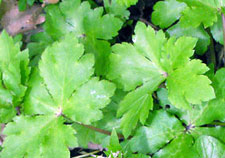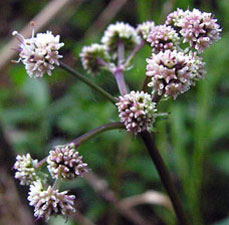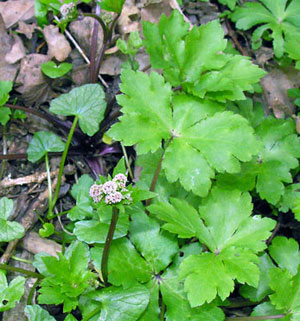Sanicle
Leaves and stem

Sanicle is generally about 15 inches (40cm) tall, but it can vary from 7 – 24 inches (20 – 60 cm). The leaves nearer to the ground tend to be larger than those higher up the plant. The leaves have a long stalk or petiole, and a palmate shape -bit like an out-stretched hand - with 3 to 5 deep wedge-shaped lobes. The leaf margin of these wedges is toothed; the ‘teeth’ may have a small bristle on the end. It is a perennial.
Flowers and Fruits

Sanicle flowers between May and August (September). The flowers are quite small, but are massed together in a ‘clump’, called an umbel. They are pinkish to greenish white in colour . The outer flowers in the clump are male (with anthers / stamens) whilst the inner ones have styles and ovaries.
When the ovules have been fertilised and the seeds form with the fruit, they are dispersed on the coats / fur of animals or clothing as there are small hooked bristles on the fruits.
Ecology and other notes

Sanicle or wood elder: Sanicula europaea. Sanicle is a member of the Carrot family. It is found in deciduous woodlands (particularly those with Ash, Oak and Beech). It is tolerant of shade, and is found across the U.K. except for areas around The Wash and the extreme north of the country; it does need some moisture in the soil.
At one stage, Sanicle was used by herbalists as it was said to be helpful in the healing of infected wounds and internal bleeding; it is not used nowadays – but for further information see http://www.pfaf.org/user/Plant.aspx?LatinName=Sanicula+europaea . The plant contains chemicals known as the saponins, which whilst not well absorbed by the body, are toxic.
Photography : courtesy of ‘Wild Flowers of the British Isles’ : visit http://ukwildflowers.com/index.htm